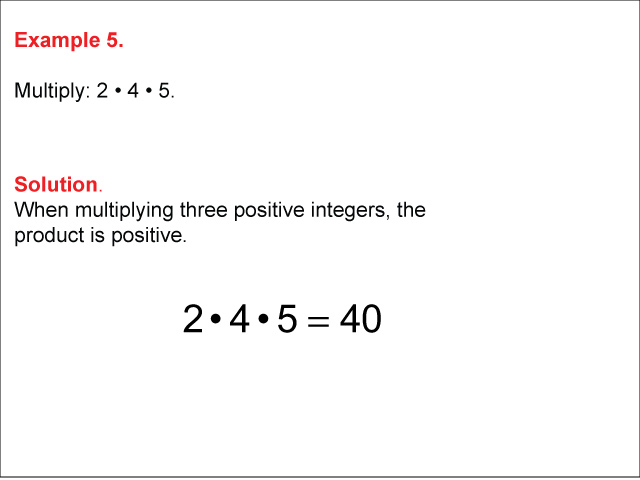
Display Title
Math Example--Numerical Expressions--Multiplying Integers: Example 5
Display Title
Math Example--Numerical Expressions--Multiplying Integers: Example 5

Topic
Numerical Expressions
Description
Example 5 illustrates the multiplication of three positive integers: 2 × 4 × 5. The solution demonstrates that when multiplying multiple positive numbers, the result remains positive. In this case, 2 × 4 × 5 = 40.
This collection of examples explores various scenarios of integer multiplication, helping students understand the rules governing the multiplication of positive and negative numbers. By presenting different combinations, including multiple factors, students can recognize patterns and develop a solid foundation for more complex mathematical operations.
Exposure to multiple worked-out examples is crucial for students to fully grasp mathematical concepts. As they encounter various problems solved using consistent principles, students can build a deeper understanding and become more proficient at solving problems independently. The slight variations in examples, such as introducing multiple factors, help students develop flexibility in their problem-solving approaches.
Teacher's Script: Now we're looking at multiplying more than two numbers. Remember, the order doesn't matter when multiplying - we can multiply these numbers in any order and get the same result. This property is called the commutative property of multiplication. As we work with more factors, keep in mind that a product of all positive numbers will always be positive.
For a complete collection of math examples related to Numerical Expressions click on this link: Math Examples: Multiplying Integers Collection.
| Common Core Standards | CCSS.MATH.CONTENT.6.NS.C.5 |
|---|---|
| Grade Range | 6 - 8 |
| Curriculum Nodes |
Algebra • The Language of Math • Numerical Expressions |
| Copyright Year | 2014 |
| Keywords | integers, integer, positive numbers, negative numbers, positive, negative, zero, multiplying integers |